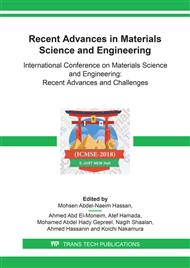[1]
Jackson W.C. And Poe C.C., The Use of Impact Force as A Scale Parameter for The Impact Response of Composite Laminates,, J Compos Technol and Res, Winter (1993).
DOI: 10.1520/ctr10380j
Google Scholar
[2]
Kakarala S.N. And Roche J.L., Experimental Comparison of Several Impact Test Methods,, Instrumented Impact Testing of Plastics and Composite Materials, ASTM STP 936, Eds S L Kessler, G C Adams, S B Driscoll and D R Ireland, American Society for Testing and Materials, (1987).
DOI: 10.1520/stp19378s
Google Scholar
[3]
Elias A, Laurin F, Kaminski M, Gornet L. Experimental and numerical investigations of low energy/velocity impact damage generated in 3D woven composite with polymer matrix. Compos Struct. 2017;159:228-239.
DOI: 10.1016/j.compstruct.2016.09.077
Google Scholar
[4]
Selver E, Potluri P, Hogg P, Soutis C. Impact damage tolerance of thermoset composites reinforced with hybrid commingled yarns. Compos Part B: Eng. 2016;91:522-538.
DOI: 10.1016/j.compositesb.2015.12.035
Google Scholar
[5]
Seltzer R, González C, Muñoz R, LLorca J, Blanco-Varela T. X-ray microtomography analysis of the damage micromechanisms in 3D woven composites under low-velocity impact. Compos Part A: Appl S. 2013;45:49-60.
DOI: 10.1016/j.compositesa.2012.09.017
Google Scholar
[6]
Gerlach R, Siviour CR, Wiegand J, Petrinic N. In-plane and through-thickness properties, failure modes, damage and delamination in 3D woven carbon fibre composites subjected to impact loading. Compos Sci Technol. 2012;72(3):397-411.
DOI: 10.1016/j.compscitech.2011.11.032
Google Scholar
[7]
Potluri P, Hogg P, Arshad M, Jetavat D, Jamshidi P. Influence of fibre architecture on impact damage tolerance in 3D woven composites. Appl Compos Mater. 2012;19(5):799-812.
DOI: 10.1007/s10443-012-9256-9
Google Scholar
[8]
N. V. Padaki, R. Alagirusamy, L. Deopura and R. Fangueiro, Influence of Preform Interlacement on the Low Velocity Impact Behaviour of Multilayer Textile Composites,, J Ind Text, vol. 20, no. 2, pp.171-185, (2010).
DOI: 10.1177/1528083710366723
Google Scholar
[9]
Wang X, Hu B, Feng Y, et al. Low velocity impact properties of 3D woven basalt/aramid hybrid composites. Compos Sci Technol. 2008;68(2):444-450.
DOI: 10.1016/j.compscitech.2007.06.016
Google Scholar
[10]
Ji C, Sun B, Qiu Y, Gu B. Impact damage of 3D orthogonal woven composite circular plates. Appl Compos Mater. 2007;14(5):343-362.
DOI: 10.1007/s10443-008-9050-x
Google Scholar
[11]
J. N. Baucom, M. A. Zikry and A. M. Rajendran, Low-velocity impact damage accumulation in woven S2-glass composite systems,, Compos Sci Technol, vol. 66, no. 10, pp.1229-1238, (2006).
DOI: 10.1016/j.compscitech.2005.11.005
Google Scholar
[12]
J. N. Baucom and M. A. Zikry, Low-velocity impact damage progression in woven Eglass composite systems,, Compos Part A: Appl S, vol. 36, no. 5, pp.658-664, (2005).
DOI: 10.1016/j.compositesa.2004.07.008
Google Scholar
[13]
Carvelli V, Betti A, Fujii T. Fatigue and izod impact performance of carbon plain weave textile reinforced epoxy modified with cellulose microfibrils and rubber nanoparticles. Compos Part A: Appl S. 2016;84:26-35.
DOI: 10.1016/j.compositesa.2016.01.005
Google Scholar
[14]
Farsani RE, Khalili S, Daghigh V. Charpy impact response of basalt fiber reinforced epoxy and basalt fiber metal laminate composites: Experimental study. Int J Damage Mech. 2014;23(6):729-744.
DOI: 10.1177/1056789513511976
Google Scholar
[15]
Kannan TG, Wu CM, Cheng KB. Open hole flexural and izod impact strength of unidirectional flax yarn reinforced polypropylene composites as a function of laminate lay-up. Polym Compos. 2013;34(11):1912-(1920).
DOI: 10.1002/pc.22598
Google Scholar
[16]
Erkendirci Ã. Charpy impact behavior of plain weave S-2 glass/HDPE thermoplastic composites. J Compos Mater. 2012;46(22):2835-2841.
DOI: 10.1177/0021998311433059
Google Scholar
[17]
Seyam A. M., Taylor D., Mohamed M., Powell N. And Meng J. 3D Woven Composites for Automotive Applications: Structure Parameters/Impact Energy Relationships,, World J Eng, Vol. 7, No. 1, Pp. 23-29, (2010).
Google Scholar
[18]
Xie, H., The Role of Fiber Type in Performance of their Composites from 3D Orthogonal Woven Preforms,, Thesis. North Carolina State University, 2016. Electronic Thesis and Dissertation.
Google Scholar
[19]
Hybon Direct Roving Fiber Glass 2022 Product Bulletin, PPG Fiber Glass, (2016).
Google Scholar
[20]
Ince, M., Performance of Composites from 3D Orthogonal Woven Preforms in Terms of Architecture and Sample Location During Resin Infusion,, Dissertation. North Carolina State University, 2013. Electronic Thesis and Dissertation.
Google Scholar
[21]
Midani M., The influence of weave and structural parameters on the performance of composites from 3D orthogonal woven preforms,, Dissertation. North Carolina State University, 2013. Electronic Thesis and Dissertation.
Google Scholar


